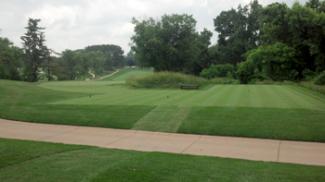Featured Golf News
River Bend Golf Club Shines Brightly After Keith Foster Remodel
The name may be nondescript - there are dozens of courses in America called River Bend - but thanks to a remodel by golf architect Keith Foster, you'll be hearing about the River Bend Club in Great Falls, Va., soon and often.

River Bend's Mighty 18th Rumbles like a Rollercoaster
It's yet another masterful reworking by Foster, who is riding the crest of a high and powerful wave of applause and acclaim, most recently for his magnificent restoration of Philly Cricket Club's fabled Wissahickon course. Now Foster has redesigned River Bend over the original routing of a 1960s'-era Ed Ault and Al Jamison course, and the results herald a sea change in the greater Washington, D.C. golf landscape. River Bend, always a tough test, is now a power to be reckoned with and likely will host some important regional tournaments as well as smaller USGA or PGA of America events.
"They fixed all the problems we had," gushed Robbie Yosaitis, a delighted member who is also a rising sophomore on the Colgate University golf team. "The old course was tired and sloppy-looking, and didn't drain well. But now it looks and plays so much better with all the different grasses and fewer trees so we can see across the golf course. Best of all it drains right away. The conditioning is perfect."
"The redesign makes the entire course much more cohesive. Finally, all the holes match in terms of concept and presentation," agreed sports broadcaster Steve Czaban, who played River Bend ever since he was a high school golfer. "Some holes that were among the worst on the course are now among the best . . . as a golf course, it's now every bit as good as any layout in the greater D.C. area."

The Connection Between Greens
& Tees is an Old School Touch
Indeed, there are two heroes of River Bend - Foster is one, but the other is course superintendent Tom Lipscomb, who helped Foster: one, steward the club through a Byzantine maze of Fairfax County permitting rules; two, rebuild every single hole on the golf course, as well as every bunker using state-of-the-art construction techniques (including a new drainage and liner system so the sand stays on the sides of the flashed faces of the bunkers); and three, effectuate an expansive tree removal. With all that to reckon with, the results somehow won the praise of the entire membership.
"Every aspect is 100 percent better," said member after member who spoke to me. Yet it was as arduous a journey as any golf course could face.
"We had to rebuild greens, fairways, tees, bunkers, rough, bridges, cart paths, streams and irrigation. We even had to build a new maintenance shed," explained Lipscomb, who actually may have understated the enormity of the project. They also had to do all the work within a rigid, unyielding set of environmental constraints: erosion concerns, sediment-retention areas and various other controls that affected every blade of grass, every stone, every grain of sand over the entire property.
The results are impressive. The conditioning is pristine, the playing surface is fast and firm, and the course is a solid test of golf. A few minor changes aside, the routing is still much the same. The former eight and nine are now 17 and 18, and vice versa, and back-to-back par-5s on the back are now a 5-3-4 sequence, with another hole removed altogether. But the golf holes themselves are now Foster originals - some with soft, sweeping S-curves creating strategic angles, others straightaway brutes rising uphill or cascading downhill with thrilling approaches to the greens.
"We're definitely a Keith Foster original now," was the general consensus of both the membership and staff, and they're right.
Perhaps the best microcosm of the sentiment is the short par-4 12th hole. What was once a dictatorial, 90-degree dogleg - an "iron off the tee and a pitch" - is now a strategic delight. At only 312 yards from the blue tees and 289 from the whites, and with the right-angle of the hole now turned into a diagonal angle of attack, there are plenty of options: drive the green, play safe with a hybrid, or try to put a 3-wood in the neck of the apron.
But no matter what you choose, even if you avoid the five fairway bunkers and lone specimen tree, the fierce green contours ensure that the adventure on the hole doesn't end upon reaching the putting surface. It can deal out anything from a two to a six, and in doing so went from being one of the weakest holes on the golf course to being perhaps the most interesting.
Some members and staff tell a humorous story about how one golfer, upon meeting Foster, said he liked the old hole, and Foster replied, "We also all remember the ugliest girl we ever met, too." When the story got around the membership, Foster's stock, already soaring, went even higher. His trademark honesty and self-effacing humor helped him earn their trust, and with the completion of each passing hole, their trust paid dividends.

The Gorgeous Par-3 Third
is a new Addition by Foster
Dividends like the gorgeous floating green at the short par-4 eighth. It would be a skyline green, the flag flittering in lonely eminence against the azure sky, if the club hadn't needed to put some distant trees down the ninth and 18th fairways. But it's still a majestic sight, perhaps the most inspiring moment on a golf course full of arresting visuals.
"I love eight for the floating green, and I also like four, where even though it's a straight line from the tee to the green, the bunkers cut in at angles and the fairway sweeps around them," Foster stated, referring to the excellent S-curve of the hole, meandering around the hazards. In doing so, he created what the old school architects called the Line of Charm, where the direct route to the green is fraught with peril, if accessible at all.
Still, the backbone of the golf course is it's collection of par-5s, all show-stoppers. From the opening par-5 - which rises gently, to the side-by-side roller-coasters at nine and 18, they are brutish in length, peppered with bunkers, lined by trees or streams, and fraught with peril.
"You can take some big number on the par-5s at River Bend if you miss even just one shot from tee to green," noted golf design expert Bruce Moulton, and he's correct, of course. No. 18 is particularly good as - like any proper 18th hole - it's a true summation of all that came before, a crescendo to end the round. Length, streams, bunkers, trees, an uphill approach - it's everything and the kitchen sink.

River Bend's Beautiful Floating Green at No. 8
There are other highly interesting little bits of character spread around the course. It not only returns to the clubhouse at nine and 18, but at two and 12 as well. On some holes, the ladies' (or forward) tees are actually set right in the fairway, an idea imported straight from some of the great U.K. courses. Finally, the walkway connecting the 14th green and 15th tee is another old school touch of class.
There are a few other things they could do to improve further. They still need to cut down a few trees - the specimen tree on the right side of the second fairway, for example, is just a bunker in the sky. One such hole is enough, and the tree on the short par-4 12th is more necessary as an architectural defense to that hole than the tree at the second hole is.
Also, while the new bunkers (similar in style to the new "Billy Bunkers" so much in vogue now) look great and drain well, they have one problem - they are too perfect. Balls tend to settle into nice lies at the bottoms for an easier escape. Bunkers are hazards, you're not supposed to have a perfect lie; you're supposed to get a fried egg from time to time, that's golf. Finally, you could have more greenside options than just a wedge back to the green. The collar of rough is usually thick and lush, though the ability to put from the front apron, when there is one, is a good compensation on some holes.
Nevertheless, these are changes readily made, little amendments easily and cheaply done. They'll actually be easier for the average golfer and tougher on the expert, which will earn the club even more points when the raters come knocking.
Between the dearth of truly great golf courses in the area and the monumental improvements accomplished by Foster, Lipscomb and team, River Bend is a rising power in the region. It not only looks light years better, it plays light years better.
And at the end of the day that's more important than accolades and trophies. After all, tournaments come and go, but the membership is forever and it is the true litmus test of the renovation's success. This membership seems unified and galvanized, absolutely thrilled with their new golf course, so now it's time for the rest of the world to take notice.
Since launching his first golf writing website in 2004, http://jayflemma.thegolfspace.com, Jay Flemma 's comparative analysis of golf designs and knowledge of golf course architecture and golf travel have garnered wide industry respect. In researching his book on America's great public golf courses (and whether they're worth the money), Jay has played over 420 nationally ranked public golf courses in 40 different states, and covered seven U.S. Opens and six PGA Championships, along with one trip to the Masters. A four-time award-winning sportswriter, Jay was called the best sports poet alive by both Sports Illustrated and NBC Sports writers and broadcasters. Jay has played about 3 million yards of golf - or close to 2,000 miles. His pieces on travel and architecture appear in Golf Observer (www.golfobserver.com), Cybergolf, PGA.com, Golf Magazine and other print magazines. When not researching golf courses for design, value and excitement, Jay is an entertainment, copyright, Internet and trademark lawyer and an Entertainment and Internet Law professor in Manhattan. His clients have been nominated for Grammy and Emmy awards, won a Sundance Film Festival Best Director award, performed on stage and screen, and designed pop art for museums and collectors. Jay lives in Forest Hills, N.Y., and is fiercely loyal to his alma maters, Deerfield Academy in Massachusetts and Trinity College in Connecticut.
Story Options
 |
Print this Story |
